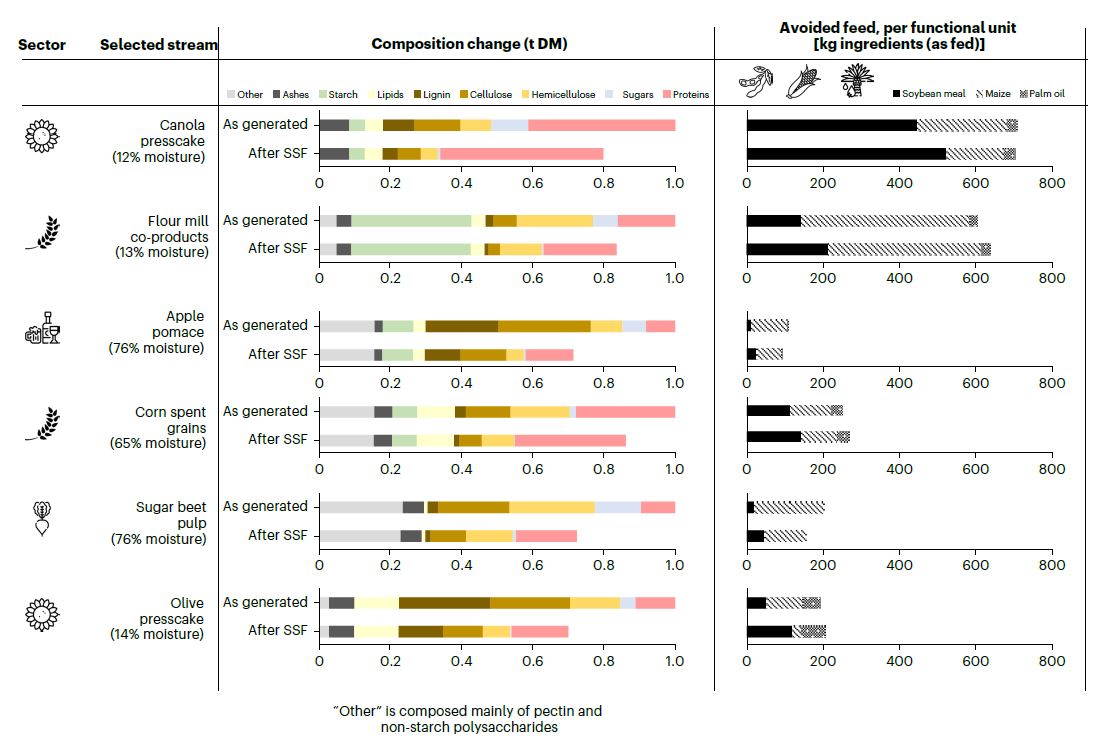September 23, 2022 | Nature Food | Source |
Introduction: Transforming agricultural waste into edible ingredients aims to reduce food system impacts, but these methods rely on new technologies and resources, with uncertain environmental benefits. A recent study by reseachers from France and Ecuador used life cycle analysis to evaluate the impacts of upgrading agrifood by-products through solid-state fermentation (SSF), as compared direct incorporation into livstock feed without SSF and anaeroic digestion (AD).
Key findings: While SSF can increase protein content in animal feed and reduce soybean meal use, it also brings environmental drawbacks, such as higher climate change and water depletion impacts. SSF tends to be better for environmental outcomes when used to upgrade food products rather than animal feed. The study found that SSF's benefits for climate change and other impacts are less than those of direct feeding methods, except for freshwater eutrophication. SSF's environmental performance varies depending on the type of co-product and how it's used. For instance, SSF upgrading to food products has shown up to ten times greater environmental benefits compared to conventional feed methods, mainly due to avoiding less sustainable ingredients like marginal wheat.
The analysis also highlighted that SSF is most beneficial when it replaces less sustainable food ingredients, while for feed markets, traditional methods may be more effective. Future evaluations should include broader waste-to-nutrition solutions and consider how emerging technologies can contribute to a more sustainable food system.
Figure | Effects of SSF on ingredients avoided by the incorporation of agrifood co-products into feed. For each stream, the biochemical composition ‘as generated’ was derived from the literature. The effects of SSF on each substrate’s composition ‘after SSF’ were simulated on the basis of a simplified model combining fungal growth and mass balance. The food-grade white-rot fungus Pleurotus ostreatus was selected as the biological agent for its established ability to degrade lignocellulose and its nutritional safety13. The N used for fungal growth was considered to be supplied with ammonium sulfate. As detailed in the Supplementary Information, the model predicts rather optimistic performances when compared with current experimental data, but it can be seen as representative of future improvements. The compositions of both fermented and unfermented streams were then translated in terms of nutritional value (for livestock) based on the SFU proxy (Supplementary Information). The relative importance of proteins, carbohydrates and palm oil (modulated by the digestibility and fibre content) in the calculated SFU allowed us to derive equivalents in terms of avoided soybean meal, maize and palm oil for each stream (with and without SSF). These are the marginal supplies of feed proteins, energy and lipids, respectively (Supplementary Information). SSF modifies not only the relative distributions of macronutrients but also the digestibility and fibre content of biomass streams; therefore, their SFU net value after SSF differs from their SFU before SSF, and the relative contributions of proteins, lipids and carbohydrates to determine the SFU value are also modified. Because the functional unit is defined per wet weight of generated agrifood co-product stream, the initial moisture content strongly shapes the magnitude of avoided feed services.





